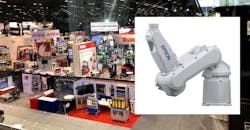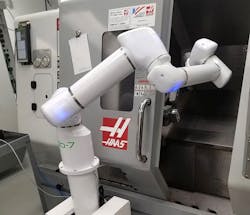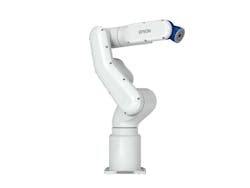Growth in the robotics market has spurred an increase in the availability of a wide range of systems for large and small applications. At Automate/ProMat 2019, robots demanded attention on the show floor. Companies had programmed their systems to show real-world applications such as placing and removing components in and out of a CNC machine to identifying a specific shaped part from a bin so that it can be sorted or removed. Then there were booths where industrial robots had been programmed to play instruments.
An interesting twist to the traditional cobot growth is the Productive Robotics OB7 (Fig. 1). Where many companies promise “easy programming,” the OB7 eliminates coding and programming. All a user needs to do is show the robot the job and it learns the steps on its own. Job modifications are simple; it’s merely one-finger drag-and-drop programming. Even complex functions like grid packaging, machine interfaces, stacking, and imported CAD paths are simple due to OB7’s learning process.
1. Productive Robotics’ OB7 learns the job on its own—no programming required.
In addition to simple programming, the OB7 is designed with seven axes so that it can reach “around” doors or other objects in the work area. This is not possible for six-axis robots. Each of the seven joints can rotate 360 degrees in both directions. The robot is designed to work in existing production environments with no need to reorganize or retool. The robot is fully functional right out of the box.
The Cobotta CVR038, from Denso Robotics, is a small, portable robot that can be easily taken anywhere to quickly automate work immediately. This industrial robot can operate in collaboration with human beings. Before using the product, the user should carry out risk assessment in accordance with regulations and standards prior to operation. This six-axis arm unit, equipped with a single-axis electric gripper end, has a total arm length of 342.5 mm and provides a position repeatability accuracy of ±0.05 mm3.
Standard cycle time of the Cobotta CVR038 is 4.32 seconds in the factory configuration and 1.6 seconds when set to maximum speed. Power requirements for the unit are single-phase 100-240 Vac ±10% at 47-63 Hz. It weighs only 4 kg.
The robot communicates externally through Ethernet (one channel), USB (two channels), or VGA (one channel). The robot comes with an emergency stop box, AC cable, AC adapter, dummy connector, manual disc, and a software DVD. Options include the Cobotta fingertip Ethernet cable, AF camera, electric gripper, mini I/O cable, and VGA relay cable.
Epson Robots provides SCARA robots, such as the VT6L, All-In-One six-axis robot introduced at Automate (Fig. 2). This entry-level offering is compact, easy to install, and includes next-generation technology for a wide range of simple applications—at a low cost of $13,900.
2. Epson’s VT6L SCARA robot offers a low-cost entry-level option.
The VT6L is well-suited for simple parts transfer applications such as machine-tool and injection molding load/unload, pick-and-place, dispensing, and simple assembly projects. The All-in-One design with built-in controller saves on valuable factory space while its SlimLine structure featuring a compact wrist pitch enables access to hard-to-reach areas in confined spaces. Many applications that were too costly to implement with standard six-axis robots will now be possible.
The VT6L offers easy integration tools such as vision guidance, with a reach up to 900 mm and a payload up to 6 kg. A feature-packed performer, it includes a hollow end-of-arm design for simplified cabling and more versatile tooling. The VT6L offers 110- and 220-V power and installs in minutes. In addition, there’s no battery required for the encoder, reducing the overall cost of ownership.
FANUC broadened its line of collaborative robots to the point where barriers to collaboration are a thing of the past. The company’s CR Series Collaborative Robots safely share the same workspace and work side-by-side with people, without the need of safety fences. These robots immediately stop after coming into contact with a person or fixed object due to safe contact stop sensor technology. In addition, these robots can be equipped with any of FANUC’s intelligent features, including iRVision, 3D vision with FANUC 3D Area Sensor, as well as the company’s force sensors.
Despite its green exterior, FANUC’s collaborative robots operate like any other traditional, yellow FANUC robot—able to repeat the same movement multiple times at the exact same dexterity. This proven technology and reliability open up myriad possibilities to automate entire assembly operations in any industry, such as automotive, packaging, distribution, metalworking, and more.
Universal Robots has created the UR+ platform, an online showroom of software and accessories that have been tested and certified to work optimally with UR cobots. From grippers to software, sensors, vision cameras, and accessories, Universal Robots+ not only enables end users to hit the ground running when integrating the company’s robots, but also provides collaboration between their robots and the flourishing developer network.
Other products available from the platform include an all-in-one plug-and-play vacuum tool from Bimba Manufacturing, EMI gripper kit from EMI Corp., Airpick from Robotiq, Gripkit-CR from Weiss Robotics, Hakko Soldering Kit from American Hakko Products, and an array of other products from companies such as Gimatic S.R.L, SMC Corp., PIAB AB, PHD Inc., etc.



